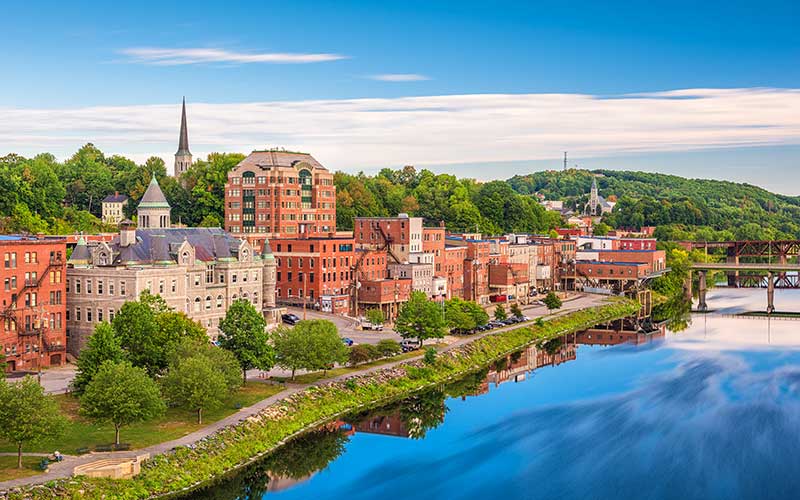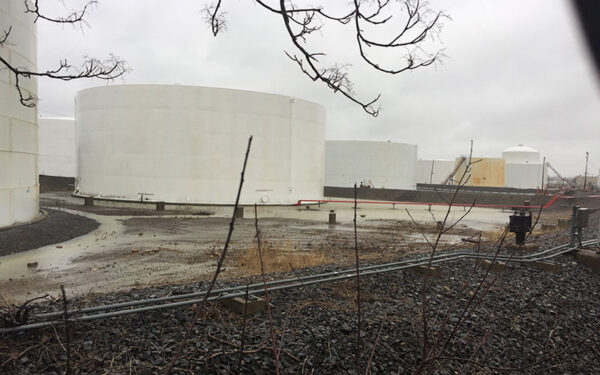
Maine can take the lead in addressing the climate crisis with an aggressive Climate Action Plan. Photo: Sean Pavone via Shutterstock
UPDATE: Today, Maine’s Climate Council released its report, “Maine Won’t Wait, A Plan for Climate Action.” This climate action plan is a critical step towards slashing climate-damaging emissions across the state. It focuses on reducing emissions, developing clean energy, protecting natural resources, building resilient communities, and helping those who have been disproportionately affected by climate impacts.
This plan came together through the combined effort of the climate council and various issue-specific working groups. It will now go to Governor Mills and the Maine legislature, who will use it to create new laws and policies designed to effectively combat the climate crisis.
Addressing the climate crisis requires cutting greenhouse gas emissions while also preparing for the impacts we can’t avoid. At the same time, we must grow and transition to a clean economy that benefits every Mainer and New Englander.
Yes, it’s a tall and complex order, but it is also imminently achievable.
Consistent with its motto of “Dirigo,” Maine can take the lead in showing New England and the rest of the country how it’s done. Last month, the Maine Climate Council began evaluating a set of recommended actions, policies, and programs proposed for the state’s “Climate Action Plan.” That plan aims to largely eliminate climate-damaging emissions from Maine’s cars, buildings, businesses, industries, and the energy sector.
From here, the Climate Council has five months to narrow down these recommendations from a somewhat generalized laundry list to a meaningful and actionable plan for the state’s future. CLF advocates – with your help – will continue to push the Council to create an aggressive plan that will definitively establish Maine as a national climate leader.
Law Lays Out Process for Creating Climate Action Plan
A central tenet of CLF’s climate work is that states must:
- own their obligations to cut carbon pollution,
- mandate science-driven emissions targets, and
- craft and follow specific (but nimble) plans to achieve climate progress.
The most effective way to achieve these goals is through enforceable climate laws that set caps on greenhouse gas emissions. Massachusetts and Connecticut passed climate laws more than a decade ago, but other New England states have been slower to follow. Maine finally stepped to the plate in 2019 thanks to a binding climate law that CLF and our allies helped to craft and pass. Now, Maine has just ten years to reduce climate-damaging emissions by at least 45% by 2030. This target is not only required by the new law but is also what scientists say is necessary to keep on track to achieve our long-term goal: cutting emissions at least 80% by 2050.
The Maine Climate Council, made up of more than 40 community and business leaders, legislators, government officials, and other stakeholders, is responsible for developing a “Climate Action Plan” for achieving those reductions. Similar to plans created by other states, Maine’s action plan will outline a policy roadmap and set of actions that collectively draw down emissions over time.
The recommendations presented to the Maine Climate Council in June represent nine months of effort from six expert working groups. These groups – energy, buildings, natural and working lands, coastal and marine areas, community resilience, and public health and transportation – were structured and staffed according to areas essential to the Climate Action Plan. My colleague Emily Green served on the transportation working group while I served on the group looking at our energy sector.
Together, the groups were tasked with taking the first cut at designing a path to drastic emissions reductions in the state. They also looked at how Maine can adapt to climate change impacts we can no longer avoid over the next 30 years.
Climate Council and Working Groups Brought Many Maine Voices to the Table
A critical consideration for every working group was the law’s mandate that the policy shifts and outcomes of the Climate Action Plan help drive our economy and leave no one behind. In short, our transition to a low-carbon economy must do more than avoid further harm to communities already made most vulnerable and marginalized by environmental and social injustice – it must actively benefit them.
That’s why the working groups, like the Climate Council itself, were designed by Governor Mills to ensure that diverse voices were at the table as this path forward is developed.
Recommendations Speak to Complexity of the Issue – But Also to Feasibility of Solutions
Mitigating climate change and preparing for its ongoing impacts – all while ensuring a transition to a growing and clean economy that benefits every Mainer – presents a complex tableau. The breadth and diversity of the working groups’ recommendations are nothing short of this. Here’s just a sampling of what they include:
- Undertake a multi-agency, stakeholder process for modeling a clean energy future. This process would include recommendations to transform the electric sector by, among other measures, driving the electrification of transportation and heating. It also would involve planning for this growth in electricity use.
- Ensure adequate clean energy supplies. This will be key to clean electrification, as will the creation of an energy financing (and potentially planning) authority.
- Improve the design and construction of new buildings – and weatherize and retrofit existing ones – to increase energy efficiency and resilience. Also, shift from heating homes and business with fossil fuels to more efficient electric options. These actions will lower both carbon pollution and heating and electric bills.
- Help cities and towns better understand, anticipate, and adapt to their climate vulnerabilities and respond to intense weather events. That will require education, technical assistance, and state-wide coordination of funding for investments in more resilient infrastructure like roads, culverts, and buildings.
- Designate a state body to coordinate decisions related to climate change and its impacts on Maine’s coastal and marine areas.
- Protect and restore marine areas so they can serve as carbon sinks. Promote other nature-based adaptation solutions.
- Reduce emissions from our transportation sector by transitioning to electric cars, trucks, and buses.
- Help Mainers drive less by improving and expanding public transit and well-sited housing and businesses. Incentivize trucks to operate more efficiently.
- Develop funding mechanisms to make the transition to clean transportation possible.
- Fund and enhance land conservation for natural carbon storage.
Next Steps Are Critical in Developing Actionable Plan
The recommendations presented to the Climate Council are excellent but, in many instances, very generalized. Now, the Council must take this list and narrow it down from broad concepts to the specific policy actions that will be most effective for achieving our goals. Those actions must include defined objectives that measure progress and ensure course correction when needed. And, the outcomes of those actions must provide both economic and social benefits – and create equity – for all Mainers.
The Council has the remaining half of this year to develop this meaningful and actionable plan. It is up to all of us to ensure that they get there. Here’s how you can get involved:
- Sign up for updates on the Maine Climate Council process. You’ll also find out about opportunities for public participation (Council meetings are open to the public).
- Review all of the working group recommendations, then offer your feedback through the Council’s online surveys.
- Send in comments on the recommendations now or stay tuned for the Council’s broader public engagement efforts starting this month.
While these recommendations are an essential step forward in creating Maine’s Climate Action Plan, there is much more work to do to ensure the final plan is aggressive enough to meet our goals while lifting all Mainers economically. The next six months are critical. Thank you, as always, for staying engaged and committed to this work.
This blog was originally published on July 8, 2020.



